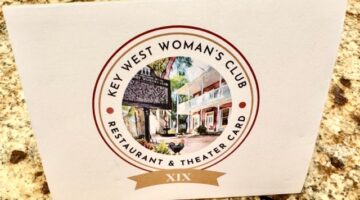Construction begins on scaled-down City Cemetery sexton’s house
BY TERRY SCHMIDA
With 2013 plans for a $532,000 sexton’s house at the city cemetery shuffled off this mortal coil, a newer, cheaper structure will soon be pushing down daisies in its place.
The deep-sixing of the old building, and new construction work began weeks ago on a $445,222 Georgian-style undertaking by Key West architect Michael Miller, near the Passover Lane entrance to the storied site.
The projected savings will be good tidings for taxpayers not exactly dying for more bad news on the City of Key West construction project front. (The New City Hall – in a hole for millions in budgetary overruns – serves as a grave indicator of how buried costs can spring to life, like zombies summoned up from the earth by a powerful houngan.)
Miller’s design will shrink the original plans by dropping a half-story from the building’s height, and decreasing the square footage from 1,510 to about 950.
The lowest qualified bidder, Pedro Falcon Electrical Contractors, of Key West, will do the actual construction work.
When completed the edifice will serve as the archives and “front office” of the necropolis, which contains the remains of as many as 100,000 people, as well as a German shepherd, three Yorkshire terriers – and a Key deer named Elfina.
The 19-acre graveyard was opened in 1847 following a hurricane that destroyed the town’s former city of the dead, at Higgs Beach. The Passover entrance will remain closed to visitors until the completion of construction, now forecast for December.
“We have one of the most historic cemeteries in the country, and perhaps the world,” said City Commissioner Clayton Lopez, whose District 6 riding encompasses the funerary grounds. “I have generations of family buried there, myself. The work we do in preserving that past, and the front page we put on it needs to be, for lack of a better word, relevant.”
Development laws revisited
In other City of Key West news, efforts have begun to reshape the rules governing land development on the island, in the hopes of making the building of affordable housing easier and less risky for developers.
The first public workshop on the subject took place May 4 at Old City Hall.
“The dollars don’t add up,” said longtime local developer – and planning board member – Michael Browning during the the hour-long meeting, which can be viewed at www.cityofkeywest-fl.gov.
Nobody wanted high-rise buildings 30 years ago, Browning added. “And now nobody can afford to live here.”
District 6 Commissioner Clayton Lopez, who was in attendance at the meeting, agreed.
“The prices are out of reach right now,” he said. “And I don’t know how [the city is] going to be able to directly influence that, other than by setting a standard with wages in city government. But with the housing we do provide, we’re going to need to include some sort of incentive to developers who are looking to build.”
Lopez pointed to experiments in rent-to-own properties as a possible starting point.
“One I’m personally familiar with took place in the ’70s in Miami,” he said. “The houses were deed-restricted, but in essence it was a way for people who were just starting out, or those running into hard times, to become first-time homeowners.”
The push to find solutions to the issue of affordable housing in a city of increasingly pricy real estate comes as the federal Department of Housing and Urban Development released its 2015 Monroe County median income stats.
The figures show that a family of four earns $70,400. At the same time the median selling price for a single-family home in Key West, from Jan. 1 to April 30, was $625,000, according the Key West Association of Realtors. The puts the median house cost at over nine times the median family’s annual income.
[livemarket market_name="KONK Life LiveMarket" limit=3 category=“” show_signup=0 show_more=0]




No Comment